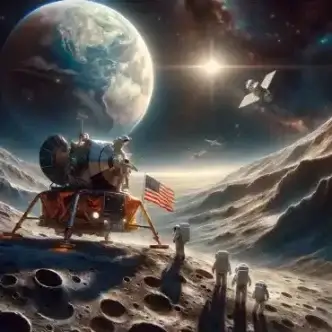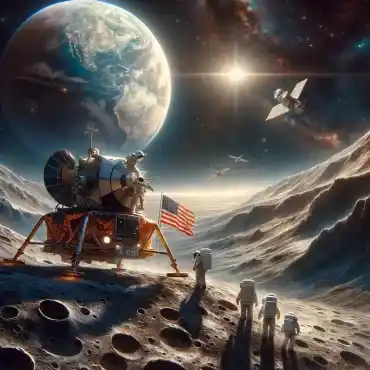“That’s one small step for man, one giant leap for mankind,” – Neil Armstrong famously said as he landed on the moon’s surface, the first man to do so. This was in 1969. It’s been over 5 decades, and no one has done it again. However, the good news is that NASA is sending astronauts to the moon’s south pole. The mission is called Artemis III. “For the benefit of all humanity, NASA and its partners will land the first woman and first person of color on the surface of the Moon with Artemis,” announced NASA in its official statement.
Notably, India landed its crewless mission on the moon in 2023. Artemis III will unlock the next frontier after it lands on the moon’s south pole, but this time with humans, making NASA the first to do so.
Let’s unpack what Artemis III is about, how it will work, and what lies ahead.
Greek Goddess of the Moon
In Greek mythology, Artemis was the goddess of the moon. Also, the twin sister of Apollo. NASA runs the Artemis program, a series of missions to the moon. They chose this name to connect it with the Apollo missions from over 50 years ago when humans first landed on the Moon.
Artemis I, completed in late 2022, was the first mission. It was a test flight without any crew. It orbited the Moon and went beyond it.
The following missions are getting ready:
- Artemis II will be the next one. This time, there will be astronauts on board. They will go farther in space than anyone has gone before.
- Artemis III will be the big one. It’s the first time astronauts will land on the Moon since Apollo 17 in 1972. NASA wants to send the first woman astronaut and the first astronaut of color to the Moon. They’ll stay there for about a week, conducting scientific studies, before returning to Earth.
- Artemis IV marks the fourth mission in the Artemis program. It involves a lunar landing with two astronauts and the delivery of the first ESA module, called I-Hab, to the Gateway.
- Artemis V, the fifth mission in the Artemis program, will land two astronauts on the Moon and deliver the second ESA module, Esprit, to the Gateway.
NASA wants to do more than repeat Apollo missions with Artemis. They want to go to the moon and stay there. That means making bases in lunar orbit and on the moon’s surface. But for now, they’re focused on returning humans to the moon by the middle of the 2020s. After successful lunar missions, they want to use Artemis technology to go to Mars with humans.
Mission Plan for Artemis III: Unveiling the Lunar Frontier
 Image courtesy: NASA 2022
Image courtesy: NASA 2022
Coming back to Artemis III, here’s what’s on the agenda. Artemis Moon missions have four main parts:
- Orion spacecraft: It is the crewed spaceship. It’s named after a famous constellation in the sky. In Greek mythology, Orion was Artemis’s friend. Orion has life support systems and shuttle interfaces. It’s the command module to take astronauts through space.
- Lunar Gateway: Gateway is a small space station that’ll orbit the Moon. It’s flexible for missions to the Moon and beyond.
- Human Landing System (HLS): HLS takes cargo and humans from Gateway to the Moon’s surface.
- Space Launch System (SLS): the launcher carries astronauts beyond Earth’s atmosphere and into space.
Here’s how it works:
Four astronauts will fly on the Orion to the Moon. First, they dock on the Gateway – the space station around the Moon.
Next, the Human Landing System, made by SpaceX, will take two astronauts down to the Moon’s South Pole. This is a place where no humans have been before.
These two astronauts will be the first woman and the first person of color to land on the Moon. They’ll spend nearly a week performing various scientific studies, including sampling water ice – first detected on the Moon in 1971. Mission control teams on the ground will stay in touch with the crew as they describe what they’re experiencing. Using advanced communication tech, they’ll send back high-quality images and videos, letting the world share in this remarkable human adventure through mission updates.
 Artemis III: Mission map. Image source: NASA
Artemis III: Mission map. Image source: NASA
While this happens, the Orion and other astronauts will keep orbiting the Moon for about 6.5 days. Then, they’ll meet up with the astronauts on the surface before being rejoined by their fellow crew from Starship.
Can Lunar Exploration Pave the Path to Mars?
Going to the Moon takes three days, but reaching Mars is much more complicated and takes longer. NASA believes Artemis is the start. It’s helping countries and companies build a community and economy on the Moon. Then, they hope to send people to Mars.
Final Words
While it was all hands on deck for NASA, they had to push back its big moon mission by two years because some of the spacecraft they planned to use had technical glitches. The Artemis III mission, which was supposed to happen in September 2025, will not be possible before September 2026. And the test mission, Artemis II, was also moved to September 2025. Nevertheless, the Artemis Moon missions represent an exciting new chapter in human space exploration, with ambitious plans to establish a sustainable presence on the Moon and pave the way for future missions to Mars and beyond. As we eagerly anticipate the unfolding of Artemis III journey, we believe the universe’s wonders are within our reach like never before.
____________
Written by: Poorva Sagar













